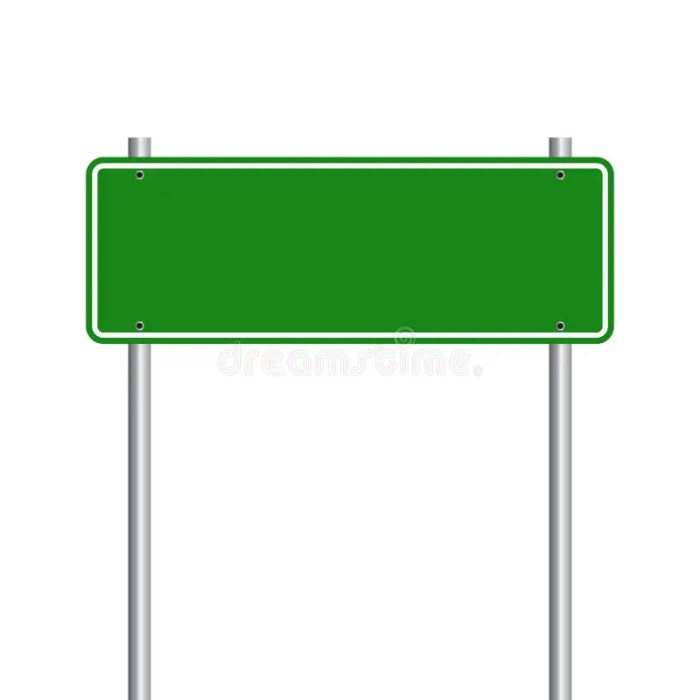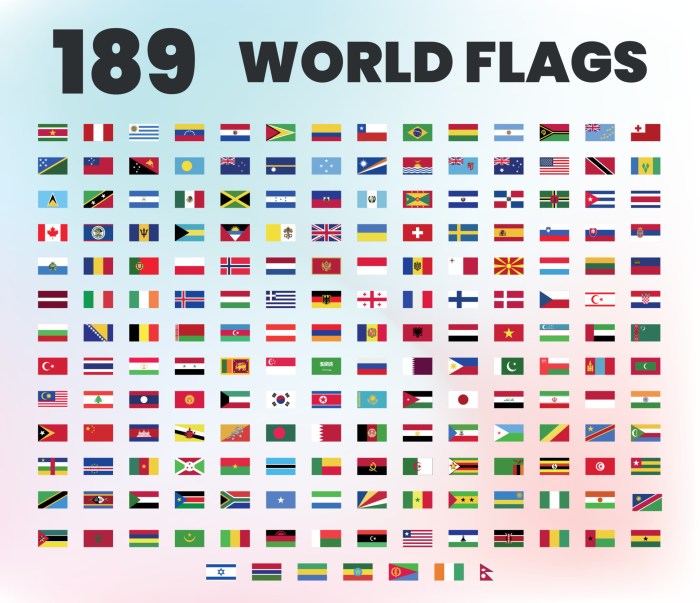If a sign has a white background – When it comes to signage, the background color plays a crucial role in determining its visibility, impact, and overall effectiveness. Among the various background colors, white holds a unique position, offering a range of advantages and psychological effects that make it a popular choice in various design contexts.
In this comprehensive guide, we delve into the world of white backgrounds, exploring their impact on text readability, accessibility considerations, and design techniques. We will uncover the psychological associations of white color and how designers harness its power to create desired effects.
By the end of this discussion, you will have a thorough understanding of the multifaceted role of white backgrounds in the realm of signage.
Background Colors and Their Impact on Visibility

Background colors play a crucial role in determining the readability and accessibility of text content. A well-chosen background color can enhance text visibility, making it easier for readers to absorb information, while an inappropriate color can hinder readability and strain the eyes.
White Backgrounds and Enhanced Text Visibility
White backgrounds are widely considered the optimal choice for text readability. White provides a high contrast ratio against dark text, making it easier for the human eye to distinguish between the text and its surroundings. This high contrast ratio reduces eye strain and improves reading speed and comprehension.
According to the Web Content Accessibility Guidelines (WCAG), a contrast ratio of at least 4.5:1 is recommended for normal text and 3:1 for large text. White backgrounds typically meet or exceed these guidelines, ensuring that text is easily visible and accessible to users with low vision or color deficiencies.
Contrast Ratio Guidelines for Accessible Design
Contrast ratio is a measure of the difference in luminance between the text and its background. The higher the contrast ratio, the easier it is to read the text. WCAG defines three levels of contrast ratio:
- Level AA:Contrast ratio of at least 4.5:1
- Level AAA:Contrast ratio of at least 7:1
- Enhanced:Contrast ratio of at least 15:1
For optimal accessibility, it is recommended to aim for a contrast ratio of at least 4.5:1 for normal text and 7:1 for large text. White backgrounds provide a high contrast ratio, making them ideal for accessible design.
White Backgrounds in Different Design Contexts
White backgrounds are commonly used in a variety of industries and design applications. In healthcare, white backgrounds are often used to create a clean and sterile environment, while in education, they are used to enhance readability and focus. White backgrounds are also popular in web design, as they can help to create a sense of spaciousness and clarity.There
are several advantages to using white backgrounds for specific design purposes. First, white is a neutral color that does not compete with other elements on the page. This makes it an ideal choice for designs that need to be easy to read and understand.
Second, white backgrounds can help to create a sense of spaciousness and openness. This can be beneficial for designs that need to feel airy and inviting. Third, white backgrounds can help to enhance the appearance of other colors. This makes them a good choice for designs that use bright and vibrant colors.Here
are some examples of effective designs that utilize white backgrounds:*
-*Websites
Many websites use white backgrounds to create a clean and modern look. This can help to improve the user experience and make it easier for visitors to find the information they need.
-
-*Brochures
White backgrounds are often used in brochures to create a professional and polished look. This can help to make the brochure more appealing to potential customers and increase the likelihood that they will read it.
-*Presentations
White backgrounds are also popular in presentations. This can help to make the presentation more readable and easier to follow.
Psychological Effects of White Backgrounds

White is a color that has been associated with purity, cleanliness, and simplicity for centuries. It is often used in design to create a sense of space and openness, and it can also be used to highlight important information.
When used as a background color, white can have a number of psychological effects on users. These effects include:
Feelings of Trust and Credibility
- White is often associated with trustworthiness and credibility. This is because it is a color that is often used in official documents, such as contracts and legal papers. As a result, people may be more likely to trust a website or app with a white background than one with a different color background.
Feelings of Calmness and Serenity
- White is also associated with calmness and serenity. This is because it is a color that is often found in nature, such as in clouds and snow. As a result, people may find that websites or apps with white backgrounds are more relaxing and calming to use.
Feelings of Spaciousness and Openness
- White can also create a sense of spaciousness and openness. This is because it is a color that reflects light, which makes it seem like there is more space in a room. As a result, people may find that websites or apps with white backgrounds are more inviting and easy to use.
Designers often use white backgrounds to create a variety of different effects. For example, white backgrounds can be used to:
- Create a sense of trust and credibility
- Create a sense of calmness and serenity
- Create a sense of spaciousness and openness
- Highlight important information
Accessibility Considerations: If A Sign Has A White Background
In the realm of digital design, accessibility plays a pivotal role in ensuring that websites and applications are accessible to all users, regardless of their abilities or disabilities. This includes individuals with visual impairments, who may face challenges in perceiving and interacting with digital content.
White backgrounds, while commonly employed in web design, can pose accessibility concerns for users with visual impairments. The high contrast between the white background and dark text can create glare, making it difficult for users to read and focus on the content.
Contrast Ratio
To address these concerns, it is crucial to maintain an adequate contrast ratio between the text and the background. The Web Content Accessibility Guidelines (WCAG) recommends a contrast ratio of at least 4.5:1 for normal text and 3:1 for large text.
This ensures that the text is easily distinguishable from the background, improving readability and accessibility for users with low vision.
Color Inversion
Another important consideration is the ability for users to invert colors on their devices. This feature, often available in accessibility settings, allows users with certain visual impairments to change the colors of the interface to improve visibility. When designing with white backgrounds, it is essential to ensure that the inverted color scheme maintains sufficient contrast and legibility.
Alternative Background Options
In some cases, it may be necessary to consider alternative background colors for users with specific visual impairments. For instance, users with achromatopsia may benefit from a black or dark gray background, while users with color blindness may prefer a background in a specific color range.
Design Techniques for White Backgrounds

White backgrounds offer a clean and versatile canvas for design. However, to leverage their full potential, it is essential to employ best practices that enhance visual appeal and create effective designs.
Typography
Typography plays a crucial role in creating visually appealing designs on white backgrounds. Choose fonts that are legible and easy to read, ensuring they stand out against the white background. Consider the size, weight, and style of the font to create visual hierarchy and guide the reader’s eye through the design.
Spacing
Adequate spacing is essential for creating a clean and uncluttered design on a white background. Use whitespace effectively to separate elements, create margins, and enhance readability. Proper spacing allows the content to breathe and prevents the design from feeling overwhelming or cluttered.
Imagery, If a sign has a white background
Imagery can be a powerful tool for creating visual interest on white backgrounds. Use high-quality images that are relevant to the design and complement the content. Ensure the images are well-sized and positioned to create a visually appealing composition. Consider using negative space around the images to create a sense of depth and draw attention to them.
Contrast and Visual Interest
To create contrast and visual interest on white backgrounds, consider using a variety of elements such as color, texture, and shape. Use contrasting colors to highlight important elements and draw attention to specific areas of the design. Incorporate textures to add depth and visual interest, while varying shapes can break up the monotony of a white background and create a more dynamic design.
FAQ Guide
Why are white backgrounds commonly used for signs?
White backgrounds enhance text visibility, provide high contrast for accessibility, and create a clean and professional appearance.
How can white backgrounds impact accessibility?
White backgrounds can pose challenges for users with visual impairments, especially those with low vision or color blindness. Proper contrast ratios and alternative text descriptions are essential for accessibility.
What design techniques can be used to create visually appealing white backgrounds?
Effective use of typography, spacing, and imagery can enhance visual appeal on white backgrounds. Consider font size, line spacing, and the strategic placement of images to create a balanced and engaging design.